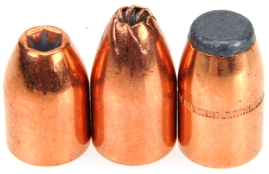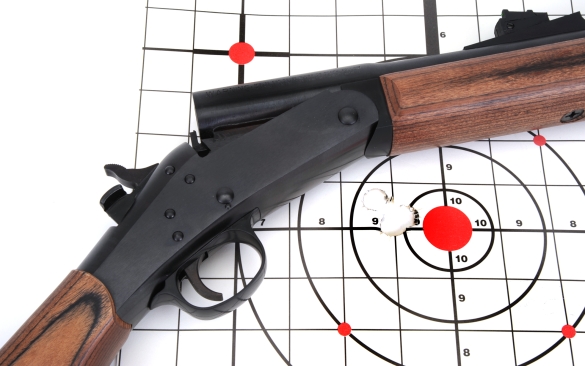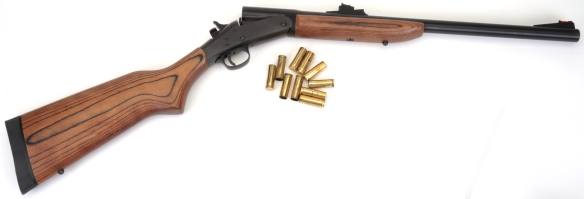
There are few really new cartridges, just a lot of subtle changeups on established themes. Which is not a bad thing, as anyone who has ever shot a 375 H&H belted magnum derivative can attest. In the case of the 500 S&W… case, the 500 S&W looks strangely familiar…. not unlike its oddly footed cousin, the 50 Beowulf.
Perspective or context? I get them mixed up…
In 1999, Alexander Arm introduced the 50 Beowulf, a 50 caliber cartridge designed to work with the AR15 platform. The 50 Beowulf, based loosely on the shorter .50 AE, has a dramatically rebated 0.445″ rim and is 0.010″ shorter than the 5.56x45mm; both characteristics intended to allow the cartridge to function in concert with an AR-15 platform. Although the Beowulf’s 69 grain capacity is similar to the 30-06 Springfield, because it’s maximum operating pressure is approximately 33,000 PSI, it is destined to be known to the  world as a short range thumper with a small foot that, for some reason, causes women to snicker.
world as a short range thumper with a small foot that, for some reason, causes women to snicker.
In 2003, S&W introduced the 500 S&W Magnum, far right, in their then new X Frame revolver. The 500 S&W Magnum s assembled overall cartridge length specification is slightly longer than that of the 50 Beowulf, however, the S&W case length is 0.031″ shorter. Seat a 400 grain Sierra bullet to the cannelure in both cartridge to a common seating depth of 0.430″ and the 500 S&W will have a net case capacity of 42 grains, while the 50 Beowulf yields 48 grains, or 6 grains more.
Loading both cartridges to their maximum pressure, approximately 33,000 PSI for the Beowulf and 62,000 PSI for the S&W, then seat a 400 grain Sierra bullets to the cannelure in both, and the 500 S&W Magnum will have a 350 fps greater muzzle velocity and 1,276 ft-lbs greater kinetic energy. Is the 500 S&W a handgun or a rifle cartridge? The answer is “Yes”.
A weight evaluating bullet selection…

Above, left to right – a Rainier Ballistic LeadSafe Bullet; 0.004″ copper plated, swaged lead core, with a recommended maximum velocity of 1,500 fps. Let’s call that target practice and heavy plinking. The second bullet is a 385 grain Remington Core-Lokt Ultra Bonded. It is designed to expand while retaining 95% of its weight. It is specifically not designed for use with the 500 S&W in a revolver, but rather with the .50 AE, a shorter cartridge. Lets call this one a moderate velocity deer or hog bullet. The final bullet is a 400 grain Sierra Sports Master, which is a bit tougher than the rest.
A plan to fully develop loads for the 500 S&W Magnum for hunting applications would surely include: Hunters Supply Hard Cast 325 grain, Barnes Buster 400 Grain, Woodleigh 400 grain Weldcore as well as heavy bullets, above 400 grains, from Cast Performance and Montana Bullet Works. The bullets initially selected were intended only to assess bullet weight and barrel length velocity results. Terminal ballistics were not being examined.
 |
|
||||||||||||
|
|
|
|
|
|
|
|
Muzzle Velocity FPS |
|
|
| Rainier LeadSafe | 335 | 45.7 | 2.020 |
Alliant 2400 | 35.0 | 1885 | 2644 | 0.7 | |
| Rainier LeadSafe | 335 | 45.7 | 2.020 |
Alliant 2400 | 39.0 | 2116 | 3331 | 0.9 | |
| Rainier LeadSafe | 335 | 45.7 | 2.020 |
Lil’ Gun | 45.0 | 2291 | 3905 | 1.2 | |
| Remington Core Lokt | 385 | 42.7 | 2.130 | Alliant 2400 | 35.0 | 1871 | 2993 | 0.6 | |
| Remington Core Lokt | 385 | 42.7 | 2.130 | Lil’ Gun | 42.0 | 2126 | 3865 | 0.7 | |
| Sierra Sports Master | 400 | 42.6 | 2.060 | Alliant 2400 | 36.0 | 1840 | 3008 | 0.6 | |
| Sierra Sports Master | 400 | 42.6 | 2.060 | Lil’ Gun | 41.0 | 2056 | 3755 | 1.0 | |
And then…
There is a lot of data out there for H110 and Win 276 powder types. I use both powders a good deal n heavy 45 Colt and 44 Magnum loads, but only when the result is full or compressed case loads. Neither have a reputation for consistent pressure generation in less than full charges. I’ve used Alliant’s 2400 for light and heavy loads with good results. In fact, low velocity cast bullet loads we list for the 500 Jeffery, a huge case, are based on very lightly loading with Alliant 2400 without filler.

I thought 50 yard accuracy was admirable. Because we shot a variety of bullet weights, each with it’s own point of impact, but shooting to the same point of aim to check group size. I was happy with the results and would not hesitate to put this rifle to work on deer or similar weight and size game out to 200 yards with a scope in place. I think groups well inside 2″ at 100 yards is a very reasonable expectation. Better is you shoot Internet groups and don’t have to actually handle the firearm.
And in merciful conclusion…
I have made fun of these rifles for a very long time… these and those old 9 shot break open H&R revolvers. Snobbery? Ignorance? Single shot hunting anxiety to disguise substandard shooting skills? Perhaps. All I can say is that I like this little gun, even if just for its purity as a firearm. It is rock solid in lock up and it stays locked up even under 63,000 PSI of chamber pressure. It’s center of gravity makes the rifle feel heavy, while it is actually a lightweight. Maybe it’s giant cartridge and subsequent huge bored barrel have something to do with that balance characteristic? I don’t know and I probably don’t care. Even so it is an easy rifle to shoot as it is steady in a shooter’s hands.

Recoil is as expected. The 400 grain loads noted above generate approximately 49 ft-lbs of recoil, about 7 ft-lbs more than my Marlin 45-70 Guide Gun 400 grain loads. The effects of recoil are exponential so a 7 ft-lbs difference is noticeable, but not severe. The Handi-Rifle lays flat under recoil, noticeably little muzzle rise. Most guys will enjoy getting thumped a bit by the Handi-Rifle’s brisk recoil, which is sort of a man-hardware high five. For effeminate, European metrosexual men who are not afraid to show their sensitive side at the range and on Facebook, it may be too much.
Are the sights less than exciting? From a site picture standpoint, not at all. Those green/red light pipes put out a lot of light with good contrast even against a dark background. The dots are not target obscuring in size and sight adjustment did not budge as a result of shooting lots of very heavy loads. Functionally, the sights are good. Would I like them to be steel? You bet. Brownells sells receiver mounted peep and steel versions of H&R sights. $20 – $30 solves the problem of plastic sights. If that isn’t enough, scope mounting bases are readily available from all major manufacturers. A fun gun to shoot and a heck of a bargain.
Harrington & Richardson’s Handi-Rifle Part 1
Harrington & Richardson’s Handi-Rifle Part 2

Email Notification